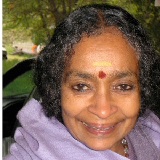
Bhagavad Gita Discourses (unknown_author)
Explorez tous les épisodes de Bhagavad Gita Discourses
Plongez dans la liste complète des épisodes de Bhagavad Gita Discourses. Chaque épisode est catalogué accompagné de descriptions détaillées, ce qui facilite la recherche et l'exploration de sujets spécifiques. Suivez tous les épisodes de votre podcast préféré et ne manquez aucun contenu pertinent.
| Date | Titre | Durée | |
|---|---|---|---|
| 18 Jun 2009 | Gita Chapter 9 | 00:55:08 | |
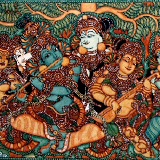 The Yoga of Sovereign Knowledge and Sovereign Secret. A powerful religious impulse permeates the ninth, tenth and eleventh chapters... The Yoga of Sovereign Knowledge and Sovereign Secret. A powerful religious impulse permeates the ninth, tenth and eleventh chapters...Visit: Vanamali Ashram’s Bhakti Yoga Home Page | |||
| 18 Jun 2009 | Gita Chapter 4 | 00:50:51 | |
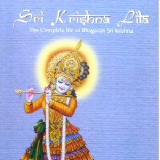 The Yoga of Knowledge and Action is the title of the fourth chapter. All existence is a working out or evolving of the One Eternal Spirit. Every Atom...imbued with the will and intelligence of the Spirit... This being the case can we call every man an Avatar? Sri Krishna reveals the secret of action and the ideal of yajna or sacrifice. The Yoga of Knowledge and Action is the title of the fourth chapter. All existence is a working out or evolving of the One Eternal Spirit. Every Atom...imbued with the will and intelligence of the Spirit... This being the case can we call every man an Avatar? Sri Krishna reveals the secret of action and the ideal of yajna or sacrifice. Mataji is the author of eleven wonderful books that share the ancient legends and timeless teachings of the Puranas and Vedas in English. Of these Sri Krishna Lila, which describes the exploits of the Blue god of Vrindavan from his birth to His disappearance is a classic. Her other books are Sri Rama Lila, Sri Shiva Lila, The Lilas of the Sons of Shiva, a translation of the Srimad Bhagavad Gita, Nitya Yoga: Essays on the Bhagavad Gita, Gurudeva and The Taste Divine which is a book on Indian vegetarian cooking (published in the US by Suny Press). Sri Krishna Lila has been published in the US under the name of The Play of God and Rama Lila as The Song of Rama. Her most recent books are Shakti: Realm of the Divine Mother and the forthcoming, Sri Hanuman Lila, (both from Inner Traditions publishers). Visit: Vanamali Ashram’s Bhakti Yoga Home Page | |||
| 18 Jun 2009 | Gita Chapter 15 | 00:50:46 | |
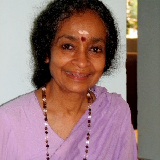 The Yoga of The Supreme Person The Yoga of The Supreme Person The 15th chapter delineates three Purushas - The Kshara, the Akshara and the Uttama. The Kshara is the Kshetra of the 13th chapter - all of visible nature. The Akshara, He says "is an eternal portion of myself that becomes the jiva in this world". "Mamaivamso jivaloke, jivabhuta sanatana". This means that each person in his spiritual reality is the very divine, however partial its actual manifestation may seem to appear to our eyes. We call it the jiva because it appears as a separate being in a world of creatures and we think of it in terms of its humanity alone. But in truth is is much greater than its appearance and is not bound by its humanity. It is in no way separate from the Purushottama, It is the Lord Himself and exists forever in the mortal world as the immortal atman within us. He takes up a body and casts it away as and when the need arises. But He is not only the Kshara and the Akshara but is above both. He is both transcendent and immanent. | |||
| 20 Jun 2009 | Gita Intro Part B | 00:37:30 | |
 Introduction: The first in a series of discourses on the Bhagavad Gita Introduction: The first in a series of discourses on the Bhagavad GitaThese talks were given at a time when I was truly inspired by the charioteer of Partha. I was in a state of ecstasy and hardly knew what I was saying. Now when I look back on these talks I am amazed at my audacity in having dared to write on something about which I knew little more than nothing. But looking back over my life I see that I seem to have continued to dare to write on things about which I knew very little. I know now that my courage which I did not even question at any time, rose from the depths of my ignorance, which again I did not question. It was only because I did not question anything that I was made into a channel through which the divine charioteer chose to reveal Himself. I knew nothing and therefore I was an empty vessel like Arjuna and by His grace, I was chosen as one of the many bards who have sung the glory of the “Song of the Lord.” I feel sure that out of all the five Pandavas, He chose Arjuna who was certainly not a scholar or a saint, for these very reasons – that he was an empty vessel, waiting for the Lord to come and fill him. May HE fill all of you who listen to these discourses with HIS grace. Aum tat Sat | |||
| 20 Jun 2009 | Gita Ch 2 Part B | 00:55:04 | |
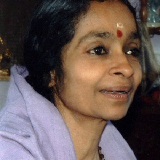 The second chapter is called Sankhya yoga but actually The second chapter is called Sankhya yoga but actuallyit deals entirely with Vedanta. The eternal nature of the atman and the ephemeral mature of the body is revealed to Arjuna. "The atman is eternal, immortal, never born and therefor can never die. It is pure consciousness and pure existence. That which is existent can never cease to exist. This is one of the laws of physics - energy can never be destroyed. it can only change its form. One body falls and the jivatman flits to another body through which it can best fulfill its destiny. Visit: www.vanamaliashram.org | |||
| 18 Jun 2009 | Gita Chapter 18 A | 01:07:46 | |
 Chapter 18. The Yoga of Liberation and Renunciation..... Chapter 18. The Yoga of Liberation and Renunciation.....“Abandon all dharmas..give yourself to the Lord alone... Fix your mind on Me, be devoted unto Me, worship Me, prostrate unto Me. I give you my solemn pledge that you shall attain Me for you are indeed dear to me.” Mataji sings her original love poems.... ORU MUKHAM MATRAM (Raga – Bairav) One face alone do I see, One melody alone do I hear. O Vanamali! Thy beauteous form alone do I nurse in my heart. O thou enchanting blue baby, Wilt thou come and be rocked in the cradle of my heart? Wilt thou remove the darkness of my ignorance? Wilt thou come and play in the courtyard of my mind? One face alone do I see, One song alone do I hear. Oru mukham maatram kaanunnu jaan, Oru swaram maatram kekkunnu jaan. Vanamali ninte prema swarupam, Eppozhum hridayathil laallikkum jan. Oru mukham maatram….. Shyamala komala unni kanna, En mana thotilil chanchatumo, En andhakarathe neekidumo, En nadumittathil vilayadumo. | |||
| 18 Jun 2009 | Gita Chapter 10 | 00:53:50 | |
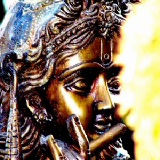 The Yoga of The Divine Manifestations The Yoga of The Divine ManifestationsThe yoga of the Gita...is the gospel of the Divinity in man which forces him out of the encasing of his lower nature to an increasing awareness of the Divine within him and outside him, through the methods of yoga... visit www.vanamaliashram.org | |||
| 18 Jun 2009 | Gita Chapter 8 | 00:50:51 | |
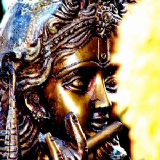 Yoga of The Impeirshable Brahman Yoga of The Impeirshable BrahmanSri Krishna explains the metaphysical concepts: Brahman, adhyatma, karma, adhibhuta... Visit: Vanamali Ashram’s Bhakti Yoga Home Page | |||
| 18 Jun 2009 | Gita Chapter 16 | 00:46:14 | |
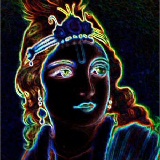 The Yoga of The Distinction Between Divine and Demonic Qualities. ...the advice of the Gita is given by an avatar or God incarnate. The recipient of the message is Arjuna, the prototype of the struggling human soul who is ready to receive the great knowledge by his close companionship and increasing nearness to the divine Self within himself. This symbolic companionship of Krishna and Arjuna, the divine and the human soul is further dramatized by the fact that their dialogue takes place amidst the din and clamor of a battlefield. The teacher in the Gita is therefore not only the God who is transcendent but also the God in man who unveils Himself through through an increasing knowledge... The Yoga of The Distinction Between Divine and Demonic Qualities. ...the advice of the Gita is given by an avatar or God incarnate. The recipient of the message is Arjuna, the prototype of the struggling human soul who is ready to receive the great knowledge by his close companionship and increasing nearness to the divine Self within himself. This symbolic companionship of Krishna and Arjuna, the divine and the human soul is further dramatized by the fact that their dialogue takes place amidst the din and clamor of a battlefield. The teacher in the Gita is therefore not only the God who is transcendent but also the God in man who unveils Himself through through an increasing knowledge... Vanamali, Nitya Yoga Mataji sings her original Love songs to Lord Krishna at the end of each talk. This music is available as Vanamali Love Songs. Mataji's books & music are available at the ashram's on-line Book & Music Store. | |||
| 17 Jun 2009 | Gita Chapter 18 B | 01:08:03 | |
 Chapter 18. The Yoga of Liberation and Renunciation... Chapter 18. The Yoga of Liberation and Renunciation...“Surrender your ego which is a myth of your own making, together with the duties imposed on you by that ego to Me the Lord sitting within the chariot of your body and I will cary you... as I carried Arjuna... I give you my absolute assurance that I Myself will lead you beyond sorrow to the highest abode”. VANAMALI KRISHNA MURAREE (Raga – Chakravakam) O Vanamali! Krishna! Muraree! Reveal thyself to me. O flute-bearer with the entrancing dark blue complexion, Let me hear the music of thy flute. Thou art the ocean and I am the wave, Thou art Krishna and I thy vanamala (garland of wild flowers). Thou alone art my lover, My beloved Vanamali. Vanamali! Krishna! Muraree! Vanamali Krishna Muraree, Darshana dedo mere pyaara…Vanamali.(repeat) Ghanashyama Sundara, Muralidhara, Sunare mujuko bansuria…….Vanamali. Tum ho sagara me hum taranga, Tum ho kaanha me vanamala. Tum ho saavaria mere pyaara…..Vanamali. Vanamali, Krishna Muraree, Krishna Muraree, Krishna Muraree. | |||
| 20 Jun 2009 | Gita Intro Part A | 00:36:02 | |
 Introduction: The first in a series of 23 discourses on the Bhagavad Gita. These talks were given at a time when I was truly inspired by the charioteer of Partha. I was in a state of ecstasy and hardly knew what I was saying. Now when I look back on these talks I am amazed at my audacity in having dared to write on something about which I knew little more than nothing. But looking back over my life I see that I seem to have continued to dare to write on things about which I knew very little. I know now that my courage which I did not even question at any time, rose from the depths of my ignorance, which again I did not question. It was only because I did not question anything that I was made into a channel through which the divine charioteer chose to reveal Himself. I knew nothing and therefore I was an empty vessel like Arjuna and by His grace, I was chosen as one of the many bards who have sung the glory of the “Song of the Lord.” I feel sure that out of all the five Pandavas, He chose Arjuna who was certainly not a scholar or a saint, for these very reasons – that he was an empty vessel, waiting for the Lord to come and fill him. May HE fill all of you who listen to these discourses with HIS grace. Introduction: The first in a series of 23 discourses on the Bhagavad Gita. These talks were given at a time when I was truly inspired by the charioteer of Partha. I was in a state of ecstasy and hardly knew what I was saying. Now when I look back on these talks I am amazed at my audacity in having dared to write on something about which I knew little more than nothing. But looking back over my life I see that I seem to have continued to dare to write on things about which I knew very little. I know now that my courage which I did not even question at any time, rose from the depths of my ignorance, which again I did not question. It was only because I did not question anything that I was made into a channel through which the divine charioteer chose to reveal Himself. I knew nothing and therefore I was an empty vessel like Arjuna and by His grace, I was chosen as one of the many bards who have sung the glory of the “Song of the Lord.” I feel sure that out of all the five Pandavas, He chose Arjuna who was certainly not a scholar or a saint, for these very reasons – that he was an empty vessel, waiting for the Lord to come and fill him. May HE fill all of you who listen to these discourses with HIS grace. Aum tat Sat | |||
| 18 Jun 2009 | Gita Chapter 7 | 00:51:46 | |
| 18 Jun 2009 | Gita Chapter 14 | 00:51:38 | |
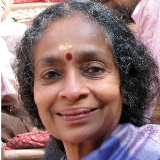 The Yoga of The Distinction Between The Three Gunas. What is Liberation? Who is it that is liberated and from what, when all is Spirit and Spirit alone. The Yoga of The Distinction Between The Three Gunas. What is Liberation? Who is it that is liberated and from what, when all is Spirit and Spirit alone.The special feature of the Gita is that it insists that "karma" or action has to be done since we live in an active universe and we cannot say that we will not act. Nature will force us to act. But this action has to be done without expectation of any personal rewards. In this way we will get out of the thrall of the law of karma. This is what is known as "nishkama karma" - when action is done as an offering to the Supreme and the results are left to Him. for indeed He is the sole doer and enjoyer. All we are asked to do is to perform the karma. This is what makes the Gita different from other schools of philosophy. Whereas all other schools say that karma is a bondage and will have to be given up eventually, the Gita says that karma is both the means and the end if done in the way that nature meant us to do. | |||
| 18 Jun 2009 | Gita Chapter 6 | 00:49:08 | |
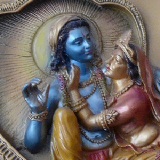 The Yoga of Self Discipline. The Yoga of Self Discipline. The divine Self is present in everything and is constantly beckoning to us... Detachment and practice are the keys to Self knowledge. Sri Krishna offers instructions for meditation. The chapter concludes extolling Bhakti Yoga. Visit: Vanamali Ashram’s Bhakti Yoga Home Page | |||
| 18 Jun 2009 | Gita Chapter 5 | 00:48:21 | |
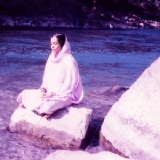 The Yoga of Renunciation And Action. The Yoga of Renunciation And Action.Is asceticism and non-action superior to action? This is one of the questions Shri Krishna addresses in this liberating teaching. ...once more the central idea of the Gita is postulated... an Infinite Being who is not merely the witness, but the enjoyer of all action done as yajna. Visit: Vanamali Ashram’s Home Page | |||
| 17 Jun 2009 | Summary Nitya Yoga The Yoga of Constant Communion | 00:41:18 | |
 Bhagavad Gita Summary-Nitya Yoga: The Yoga of Constant Communion. The purpose of the Gita is to fashion a God out of this mortal clay- to unveil the divinity within the humanity... Bhagavad Gita Summary-Nitya Yoga: The Yoga of Constant Communion. The purpose of the Gita is to fashion a God out of this mortal clay- to unveil the divinity within the humanity..."Abandon all dharmas..give yourself to the Lord alone... Fix your mind on Me, be devoted unto Me, worship Me, prostrate unto Me. I give you my solemn pledge that you shall attain Me for you are indeed dear to me." | |||
| 18 Jun 2009 | Gita Chapter 11 | 00:53:52 | |
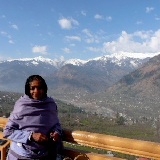 The Yoga of the Vision of Cosmic Form The Yoga of the Vision of Cosmic Form...the illusion that all things exist separate from God has been dispelled from his mind. He realized that all nature is but a revelation of that Godhead... Mataji’s love songs are translated at at the www.vanamaliashram.org Vanamali Love Songs page. Her Vanamali love Songs album is available at the Ashram’s on-line store. Visit: Vanamali Ashram’s Bhakti Yoga Home Page | |||
| 18 Jun 2009 | Gita Chapter 13 | 00:36:44 | |
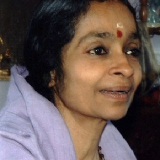 The Yoga of the Distinction Between the Field and the Knower of the Field. The Yoga of the Distinction Between the Field and the Knower of the Field.In the thirteenth chapter, Lord Krishna says that the entire universe is a field for the play of god. This field has two parts. On the universal level it includes the whole of cosmic manifestation and on the individual level it consists of the body, mind, intellect and ego. The first cannot be separated from the other. It is only now that western science is coming to understand this truth. The Gita describes this all Knower or Supreme Consciousness as the kshetrajna or the knower of the field. The field may be composed of many items but the Knower is one. He is the Lord of all and is seated within the heart of every creature. “sarvatha panipadam tat sarvata shishiromukham, sarvathasrutimanloke, sarvamavritya thishtati.” This Being in whose embrace we live has feet of swiftness and hands of strength on all sides; It has faces, eyes and noses everywhere. It listens to both the throb of the universe as well as the silence of eternity. Though bodiless it has a million bodies. It is the perceiver of all things even though it has no sense organs. It is without attributes yet is the enjoyer and sustainer of all attributes. Attached to nothing, it supports all the action and movement of its Prakriti. It is at once the inner and the outer, the far and the near, the moving and the unmoving. It is the subtlest of the subtle, beyond the grasp of our minds as well as the density of matter which we can see and touch and smell and hear. It is the light of all lights beyond the darkness of ignorance. It is knowledge, the object of knowledge and the goal of knowledge. Despite its greatness it is seated in the hearts of all as the charioteer of our lives! At last the great teacher says to his disciple Arjuna, “O Arjuna, whatever exists whether movable or immovable know it to have come from the union of the kshetra and the kshetrajna, the field and the knower of the field”. This is the knowledge which will carry us beyond death to immortality. It is only when our inner eye opens and we see this truth that we can be called “seers”. This is that supreme consciousness about which western science is still to know. Without knowing that consciousness humankind can never know the meaning of true fulfillment or peace. | |||
| 20 Jun 2009 | Gita Ch 2 Part A | 00:51:00 | |
 The second chapter is called Sankhya yoga but actually The second chapter is called Sankhya yoga but actuallyit deals entirely with Vedanta. The eternal nature of the atman and the ephemeral mature of the body is revealed to Arjuna. "The atman is eternal, immortal, never born and therefor can never die. It is pure consciousness and pure existence. That which is existent can never cease to exist. This is one of the laws of physics - energy can never be destroyed. it can only change its form. One body falls and the jivatman flits to another body through which it can best fulfill its destiny. Visit: www.vanamaliashram.org | |||
| 18 Jun 2009 | Gita Chapter 17 | 00:50:11 | |
| 20 Jun 2009 | Gita Chapter 1 | 00:50:23 | |
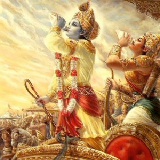 The first chapter is called Arjuna Vishada Yoga: Union By Means Of The Despondency Of Arjuna. The word Yoga means union. Thus any activity which enables us to obtain union with the Divine can be called a yoga. ...The message of the Gita is thus addressed to the fighter- the man of action... life is the battlefield of Kurukshetra which each one of us has to learn to face and fight our way through, before we can reach the other side which is Dharmakshetra. The first chapter is called Arjuna Vishada Yoga: Union By Means Of The Despondency Of Arjuna. The word Yoga means union. Thus any activity which enables us to obtain union with the Divine can be called a yoga. ...The message of the Gita is thus addressed to the fighter- the man of action... life is the battlefield of Kurukshetra which each one of us has to learn to face and fight our way through, before we can reach the other side which is Dharmakshetra. Each chapter begins with the sanskrit chanting of the chapter the english discourse follows. Visit: www.vanamaliashram.org | |||
| 18 Jun 2009 | Gita Chapter 12 | 00:39:15 | |
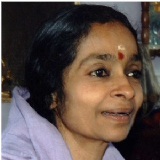 The Yoga of Devotion Lord Krishna unites the triple strands of divine love, divine knowledge and divine works, Bhakti, Jnana and Karma and unites them into one. Creature, creator and creation blend into one... This is the supreme teaching of the Gita. Visit: Vanamali Ashram’s Bhakti Yoga Home Page | |||
| 18 Jun 2009 | Gita Chapter 3 | 00:51:29 | |
 Karma yoga the yoga of action is the theme of the third chapter. This is one of the most difficult sections in the whole text and provides a key to understanding the whole message. Chapter 3, 4 and 5 of the Gita deal exhaustively with Karma yoga. However we find that even in the 6th chapter the Lord starts by reiterating what has already been said. “Anashrita karmaphalam … He who performs his swadharma without any dependence “anashrita” on the fruits of his action, he is both the karma yogi and the karma sannyasin. Meaning to say one who dedicates himself to perform the bounden duties of his life with no dependence of any type on their results is both a yogi and a sannyasi. Karma yoga the yoga of action is the theme of the third chapter. This is one of the most difficult sections in the whole text and provides a key to understanding the whole message. Chapter 3, 4 and 5 of the Gita deal exhaustively with Karma yoga. However we find that even in the 6th chapter the Lord starts by reiterating what has already been said. “Anashrita karmaphalam … He who performs his swadharma without any dependence “anashrita” on the fruits of his action, he is both the karma yogi and the karma sannyasin. Meaning to say one who dedicates himself to perform the bounden duties of his life with no dependence of any type on their results is both a yogi and a sannyasi.Visit: Vanamali Ashram’s Home Page | |||
Améliorez votre compréhension de Bhagavad Gita Discourses avec My Podcast Data
Chez My Podcast Data, nous nous efforçons de fournir des analyses approfondies et basées sur des données tangibles. Que vous soyez auditeur passionné, créateur de podcast ou un annonceur, les statistiques et analyses détaillées que nous proposons peuvent vous aider à mieux comprendre les performances et les tendances de Bhagavad Gita Discourses. De la fréquence des épisodes aux liens partagés en passant par la santé des flux RSS, notre objectif est de vous fournir les connaissances dont vous avez besoin pour vous tenir à jour. Explorez plus d'émissions et découvrez les données qui font avancer l'industrie du podcast.
© My Podcast Data
